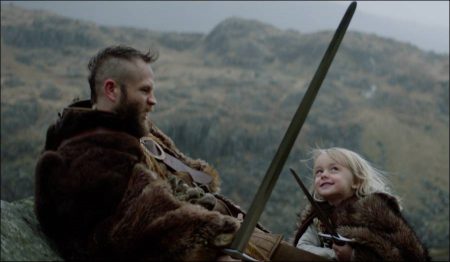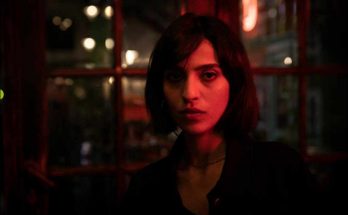The Place of No Words movie has a startling opening. It captures a young boy and an adult in a contemporary bedroom, having a conversation that features a good deal of nonsense words, and aside from the super-wide aspect ratio of the frame, looks pretty much exactly like any generic indie family drama you’d care to invoke.
But there’s a sudden cut, to an epic view of a wide open sea, and a wide, long, rowboat. The man, played by Webber, now has a thick long beard (his hair and beard stylings in this movie are a lot, and I mean that literally) and is furiously hoisting oars as the child sits facing him while the sea roils noisily.
Subsequent gorgeous shots suggest a Viking epic. (The cinematographer is Patrice Lucien Cochet, who contributes inspired work throughout.) As do the characters’ costumes: fur capes, elaborate leather boots, and swords. Soon as this pair reached land, they start climbing a mountain. Looks like maybe they’re headed to a photo shoot for a Led Zeppelin reunion album.
Film Review for The Place of No Words
You can almost envision a conventional rendering of Mark Webber’s enchanting “The Place of No Words,” the writer-director’s fifth and most ambitiously scoped feature. In that scenario, the magical journey through which a three-year-old grapples with his father’s terminal illness — something he is too young to make sense of in real-world terms — would be adorned with vivid colors and on-the-nose emotions aimed at tear ducts. Conceived through a personal lens, “The Place of No Words” thankfully takes the completely opposite approach. While occasionally wearisome in its fragmented structure (and limited in its commercial appeal), Webber’s film navigates the vast notion of grief gently and with seriousness.
With its modest intentions, “The Place of No Words” loosely brings to mind David Lowery’s similarly experimental “A Ghost Story,” in a good way — which is to say, those who are patient with its deliberate shapelessness will be eventually rewarded with something both intimate and gradually immersive à la “Where the Wild Things Are.” While the disorderly open-ended narrative and layers of mythical metaphors are risky (and at times distancing) artistic choices, they make perfect sense for Webber, considering the unique cinematic place the actor-turned-director has carved out for himself.
In the distinct footsteps of his earlier movies like “The End of Love” and “Flesh and Blood,” the filmmaker’s latest sees him continue to grow into his creative voice, both as a performer who’s stretched a range of dramatic muscles alongside boundary-pushing directors — Lars von Trier, Jim Jarmusch, and Todd Solondz among them — and a storyteller pursuing what he calls “reality cinema.” Once again, Webber casts himself and members of his family (his son Bodhi Palmer and wife Teresa Palmer leading the pack) in “The Place of No Words,” as part of the ongoing dogma of his self-defined brand of filmmaking.
While it’s hard to make a critical case for the heightened authenticity this casting philosophy was supposed to inject into “The Place of No Words,” Webber’s instincts pay off, especially with Bodhi. The tiny (and yes, impossibly cute) first-time actor somehow turns his character’s innocent confusion about death into something otherworldly. What we see on the screen is mostly what Bodhi experiences and reacts to with his inventive eyes, as his million-dollar question (“Where do we go when we die?”) sends his family off to a strenuous excursion across medieval castles, choppy seas, and mountainous landscapes.
Webber’s repeat cinematographer Patrice Lucien Cochet traces their mystical expedition through the wilderness with his cold-to-the-touch, tranquil photography, intensifying the damply mossy textures and light reflections of the film’s remote locations (various countryside spots across Wales), as the clan braves the elements and crosses paths with numerous wondrous creatures along the way.
These fantastical sequences are often ably (sometimes, distractingly) complemented with real-life episodes, mostly set in the family’s bright and hipster-ish apartment. Also an editor, Webber toggles between and overlaps reality (birthday parties, hospital visits, and spiritual talks) and make-believe (farting swamps, fizzleberries, grumblers, and knights) until one can’t tell the difference.
In certain segments, the filmmaking can’t escape the much-imitated Terrence Malick/“Tree of Life” territory. Fortunately, these occasional sun-dappled and twirling affectations don’t invalidate an original whole, which honors a child’s gloriously untamed mind and parents who carefully cultivate it with affection. In that, a number of cozy scenes crystallize the encouragement Bodhi receives from adults to widen his imagination.
During one such instance, Teresa reads Jackie Morris and Robert Macfarlane’s “The Lost Words” to Bodhi; an illustrated spell book aspiring to deposit some increasingly unpopular nature-themed words back into the everyday vocabulary of children. While it makes for a fleeting moment in the film, “The Lost Words” sharpens our awareness of Bodhi as a uniquely observant kid who sees the magic and meaning of nature everywhere he looks. He not only grandly embellishes the family’s journey with that advanced perceptiveness, but he also takes note of his father’s sadness and comprehends the farewell-like finality of a random “I love you.”
“The Place of No Words” leaves much to be desired from Teresa. Save for a few noteworthy scenes, the story sometimes pushes her to the background, instead of expanding upon the loneliness she expresses while talking about her husband’s imminent passing to a friend. Still, this adventurous and often dream-like film manages to convey a strangely optimistic and freeing image of death, without tying a saccharine bow on the cosmic query of afterlife. Like the bittersweet memory of a departed loved one, “The Place of No Words” is the kind of beast you’ll instinctively remember even if you try to move on from it.
The Place of No Words (2020)
Directed by: Mark Webber
Starring: Mark Webber, Teresa Palmer, Bodhi Palmer, Eric Christian Olsen, Nicole Elizabeth Berger, Sarah Wright, Phoebe Tonkin, Anna Schafer, Mary Benn, Misha Ade
Screenplay by: Mark Webber
Production Design by: Ciaran Thompson
Cinematography by: Patrice Lucien Cochet
Film Editing by: Mark Webber
Costume Design by: Annabelle Harron
Art Direction by: Dave Tremlett
MPAA Rating: None.
Distributed by: Gravitas Ventures
Release Date: October 23, 2020 (United States)
Views: 109






